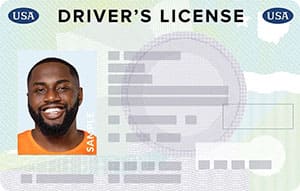- 0 Incorrect (8 allowed to pass)
- 0 Correct
- Updated for February 2025
- Based on official Utah Driver's manual
Free Utah DMV Permit Practice Test Two 2025
You finally decided to make your license-less period of life a thing of the past – wise decision! If you want to move on to its practical realization, you need to pass a DMV Permit Test which assesses your knowledge of driving theory as described in the latest version of the official Utah Driver Handbook. Our 2nd UT permit practice test is also based on this document and has the same question format and scoring system as a real DMV exam, which means… yes, you’ll be much better prepared if you practice with us.
You can do it without leaving your home ant any time convenient for you – all for free. Surprised or suspicious? Relax, you can take a look and see for yourself – you’ll find that no registration is required. So why wait – start now!
The 40 multiple-choice questions of our test have four answers each – just click the correct one. It’s a good idea to read the driver handbook first but even if this doesn’t help, you can use our hints (please note that a real DMV exam doesn’t have hints). How do you know if your attempt is successful? Easy – the progress bar on the left-hand side of the screen will give you immediate feedback – the green color means “correct”, red means “oops!” In the former case you are directed to the next question, in the latter you are given an explanation of your mistake – take your time and read it carefully. Carry on like this to the end of the test and check your final score.
You can always redo our UT permit practice test at no cost – the tasks will be randomized for you. If you find it helpful, tweet your friends about it or simply hit the “Like” button above. Start materializing your dream – good luck!
- Perfect for learner’s permit, driver’s license, and Senior Refresher Test
- Triple-checked for accuracy
What you need to know

What to expect on the actual UT DMV exam
questions
correct answers to pass
passing score
minimum age to apply
Helpful links
List of questions (classic view)
- What does this sign indicate?
- Vehicles approaching a roundabout must
- You are preparing to turn left at an intersection when you see an oncoming vehicle. What should you do?
- Shared center lanes that are marked on each side by a solid yellow line and a dashed yellow line are reserved for _________ and can be used by vehicles traveling in either direction.
- If you are having vehicle trouble and need to stop, what is the first thing you should do?
- If you are approaching an intersection and see a steady yellow traffic light, you should
- Which of the following right-of-way rules is FALSE?
- Which of the following is NOT a proper step in parallel parking on the right side of the road?
- To enter a main road from a driveway, an alley, or the roadside, you must
- What does this traffic sign mean?
- You are driving in heavy traffic. An emergency vehicle with its lights flashing is right behind you. What should you do?
- Regulatory devices tell you
- If you miss your exit on a freeway, you should
- You drive up to an intersection and see a yield sign. You must
- Before you enter an intersection, you must look for
- On a roadway with three or more lanes going in the same direction, which lanes usually offer the smoothest flow of traffic?
- If you are going to stop or slow down where others might not expect it, you should _________ to warn those behind you.
- When approaching or driving through a work zone, you should NOT
- When passing a large vehicle, do not pull back in front of the vehicle until you can see
- At railroad crossings that are only marked with a stop sign, you must stop and then proceed only when
- This sign is
- Which of these statements is FALSE?
- When passing another vehicle, get through the other driver's blind spot as quickly as you can
- When you reach a marked or unmarked crosswalk, you must yield to
- When you drive in city traffic, you should try to look at least
- A steady red arrow signal means
- If a truck is trying to pass you, you can help the truck driver by
- If you are changing lanes, preparing to pass another vehicle, or entering traffic, signal and check for passing traffic. First, use your mirrors. Then
- If your vehicle's wheels drift onto the shoulder of the road, you must
- When stopped behind another vehicle on a hill, you should stay back at least
- On two-lane, two-way roads, you may pass on the left only if
- Which of the following rules about turning is FALSE?
- When entering an interstate highway from an acceleration lane, you must
- In Utah, you may make a left turn at a red light if you are turning
- A sign with black letters or symbols on an orange background is
- At night, you should use your high-beam headlights in all of the following situations EXCEPT
- You're driving on a two-lane road and need to turn around. If the road is too narrow to make a U-turn, you may make
- What does this sign mean?
- What does this sign mean?
- Which of the following types of signs inform you of possible hazards ahead?
More resources
- Alabama: Test 1 / Test 2
- Alaska: Test 1 / Test 2
- Arizona: Test 1 / Test 2
- Arkansas: Test 1 / Test 2
- California: Test 1 / Test 2
- Colorado: Test 1 / Test 2
- Connecticut: Test 1 / Test 2
- Delaware: Test 1 / Test 2
- District of Columbia: Test 1 / Test 2
- Florida: Test 1 / Test 2
- Georgia: Test 1 / Test 2
- Hawaii: Test 1 / Test 2
- Idaho: Test 1 / Test 2
- Illinois: Test 1 / Test 2
- Indiana: Test 1 / Test 2
- Iowa: Test 1 / Test 2
- Kansas: Test 1 / Test 2
- Kentucky: Test 1 / Test 2
- Louisiana: Test 1 / Test 2
- Maine: Test 1 / Test 2
- Maryland: Test 1 / Test 2
- Massachusetts: Test 1 / Test 2
- Michigan: Test 1 / Test 2
- Minnesota: Test 1 / Test 2
- Mississippi: Test 1 / Test 2
- Missouri: Test 1 / Test 2
- Montana: Test 1 / Test 2
- Nebraska: Test 1 / Test 2
- Nevada: Test 1 / Test 2
- New Hampshire: Test 1 / Test 2
- New Jersey: Test 1 / Test 2
- New Mexico: Test 1 / Test 2
- New York: Test 1 / Test 2
- North Carolina: Test 1 / Test 2
- North Dakota: Test 1 / Test 2
- Ohio: Test 1 / Test 2
- Oklahoma: Test 1 / Test 2
- Oregon: Test 1 / Test 2
- Pennsylvania: Test 1 / Test 2
- Rhode Island: Test 1 / Test 2
- South Carolina: Test 1 / Test 2
- South Dakota: Test 1 / Test 2
- Tennessee: Test 1 / Test 2
- Texas: Test 1 / Test 2
- Utah: Test 1 / Test 2
- Vermont: Test 1 / Test 2
- Virginia: Test 1 / Test 2
- Washington: Test 1 / Test 2
- West Virginia: Test 1 / Test 2
- Wisconsin: Test 1 / Test 2
- Wyoming: Test 1 / Test 2
Your go-to, trusted source
Experience the Driving-Tests differenceOur commitment to accuracy and quality in our practice tests
Explore our rigorous, multi-tiered verification process that ensures each question mirrors the official manual for unparalleled accuracy.

At Driving-Tests.org, we understand the importance of reliable and accurate practice tests to help you prepare for your DMV exam. That's why we've developed a meticulous process to create and continually update our practice questions, ensuring they reflect the most current driving laws and regulations.
Here's an inside look at how we maintain the highest quality in our practice tests.
Content Creation and Verification Process
- Alignment with Official Manuals:
Every question we develop is based on the most recent version of each state's official driving manual. Our team regularly monitors each state DMV's website for the latest updates to ensure our practice tests are always aligned with the most current information. - Community Feedback Integration:
We leverage feedback from our vast community of users to understand which topics are most frequently tested. This helps us focus on the areas that are most relevant and beneficial for your preparation. - Expert Content Creation:
Our in-house editor, Steven, who has extensive experience in driver education, crafts each question with precision. He conducts a thorough review of each question against the official manuals to ensure accuracy. - Rigorous Review Process:
Once Steven has finalized a set of questions, our team conducts a joint review session. This second level of scrutiny involves content accuracy, proofreading, and fact-checking to eliminate any errors. - User Feedback Mechanism:
After a question goes live on our site, we keep the lines of communication open. Each question features a feedback button, inviting users to report any issues or errors. This continuous feedback loop allows us to address and rectify any concerns promptly. - Responsive Updates:
In line with our commitment to accuracy, we quickly update our practice questions to reflect any changes in the DMV manuals. Additionally, we update the free electronic copy of the state's driver's license manuals on our site, typically within a few days after the DMV publishes them.
Our thorough quality control process ensures that you have access to practice tests that are as accurate and up-to-date as possible. We believe in the power of well-prepared drivers and are dedicated to providing you with the best study tools to help you succeed on your DMV exam.
Unlock Your Best Chance to Pass
Get instant access to 650+ exam-like questions tailored for UT.
See how Premium can help you pass faster, risk-free, with our 97% success rate.
Utah questions seen on the real test
Questions specific to your state. Breeze through your exam with the right tools.
97% of Premium users pass the first time
Compare with the average passing rate of just 49%.
Premium users succeed.Trusted by over 1.15 million customers
The only program recommended by DMVs nationwide.





